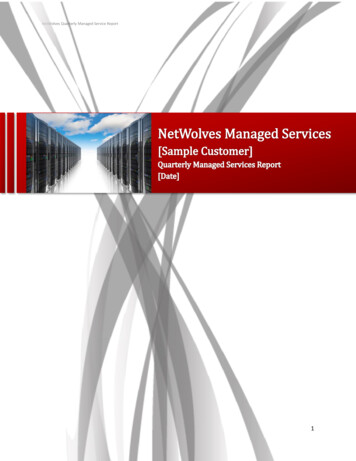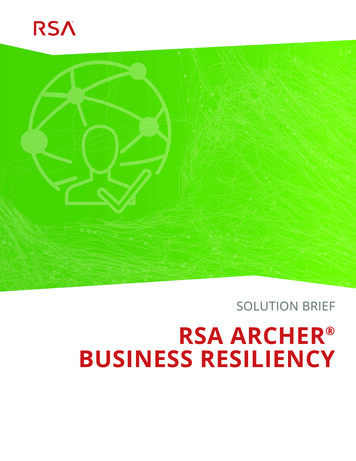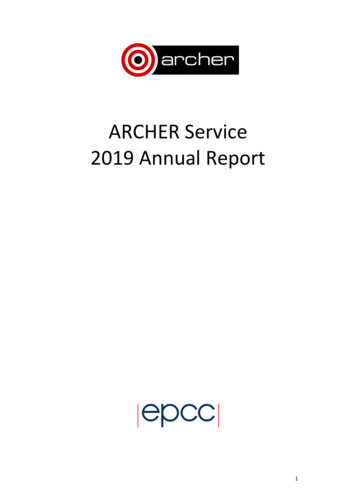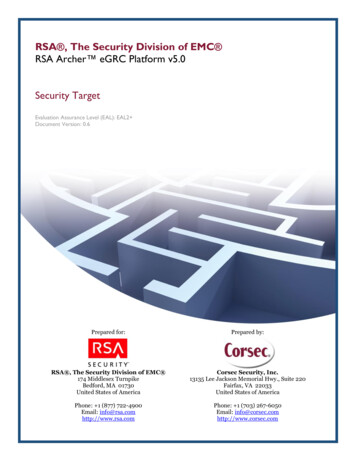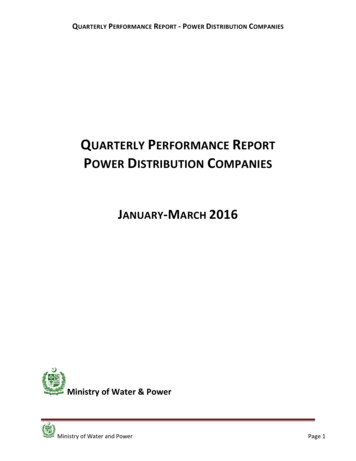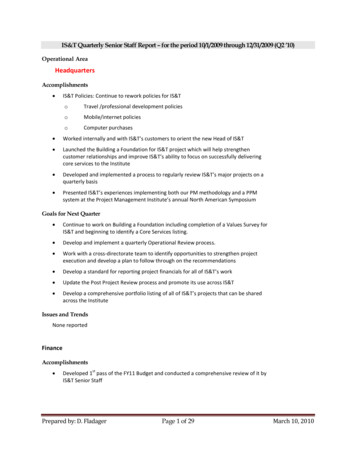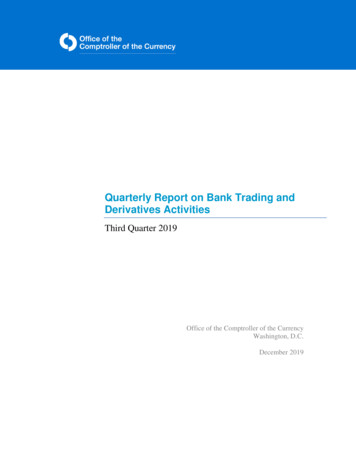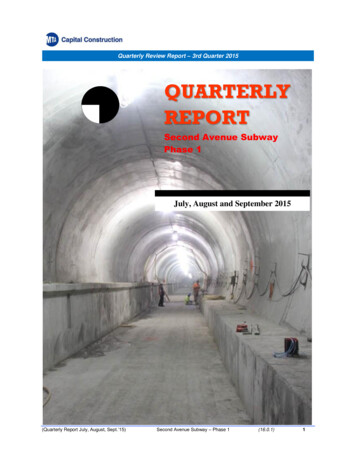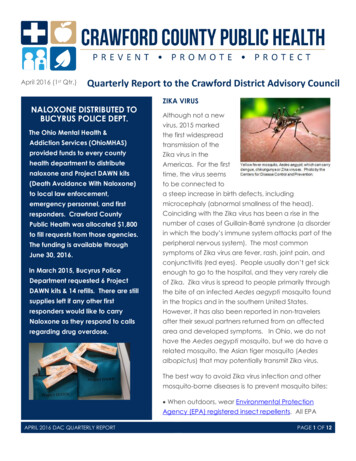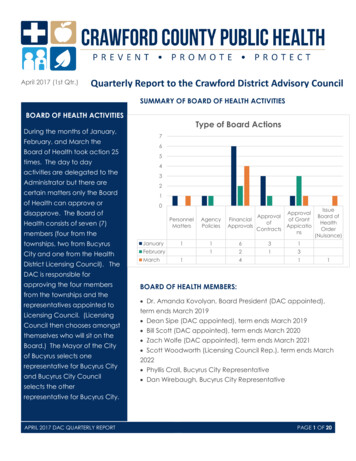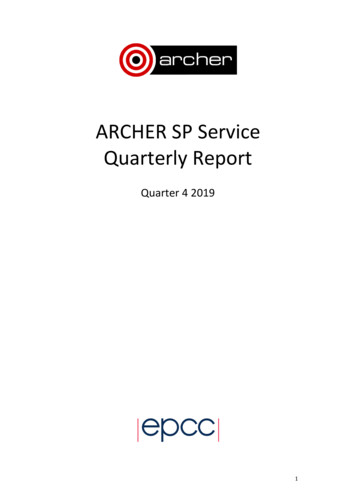
Transcription
ARCHER SP ServiceQuarterly ReportQuarter 4 20191
Document Information and Version HistoryVersion:Status1.0ReleaseAlan Simpson, Anne Whiting, Paul Clark, Andy Turner, Linda Dewar,Stephen Booth, Jo Beech-BrandtAuthor(s):Reviewer(s)VersionAlan 31/12/1905/01/200.61.013/01/2014/01/20Comments, Changes, StatusInitial DraftAdded metrics for October andNovemberAdded HPC Systems informationAdded December figuresAdded usage and utilisation chartsand phone informationReview and minor updatesVersion for EPSRCAuthors, contributors,reviewersAnne WhitingAnne WhitingLinda DewarAnne WhitingJo Beech-BrandtAnne WhitingAlan Simpson & Anne Whiting2
1. The Service1.1 Service HighlightsThis is the report for the ARCHER SP Service for the Reporting Periods:October 2019, November 2019 and December 2019. Utilisation over the quarter was 89% which is an increase from the previous quarter where theutilisation was 86%. In order to facilitate faster data movement to the RDF GPFS filesystems from the ARCHER loginnodes, the existing bonded pair of 10gbit links from the ARCHER core switches to the RDFsitewide network has been upgraded to a pair of 40gbit links. The increase in transfer speed willassist users in transferring data from ARCHER to ARCHER2 via the RDF. PBS, the job scheduler for ARCHER, has been upgraded from version 12.2.401 to version 13.0.412to take advantage of improvements and fixes to issues provided in the upgraded version. A Business Continuity and Disaster Recovery (BCDR) scenario test was carried out in October. Theaims of such tests are to verify the processes in place, identify improvements and to ensure thatstaff have had the necessary training should such an event occur, whilst maintaining anuninterrupted service to our users. A scenario was used of a food poisoning outbreak coveringboth the staff based at the Bayes Centre and the HPC Systems team at the ACF. Staff includingmanagers at all levels were randomly ‘afflicted’ by the outbreak and removed from active servicethroughout the day. The remaining team used existing processes to identify a chain of commandand to ensure that critical services such as the helpdesk were kept running uninterrupted. Noteswere kept by all those involved on how things went and any issues that could be improved. Afterthe test was complete a lessons learned review was carried out and actions taken to address anyimprovements identified. There were no interruptions to service and the user community wasunaware that it had taken place. Exercises such as this help to prepare our staff and to improveour processes to help ensure we keep the services running as best we can in case of majorincidents in the future. EPCC is delighted to be able to announce that they have passed a 4-day combined external auditof ISO 9001 Quality Management and ISO 27001 Information Security Management. ARCHER andCirrus, our Tier-2 service, are both in scope for these certifications. The success in achievingthese certifications reflects the importance we place on delivering the best and most secureservice to our users and to taking action on feedback received to improve our service. To contribute to the utilisation of ARCHER over the holidays, the weekend queue was inoperation throughout the festive period, from 18:00 Friday 20th December until 06:00 onMonday 6 January. Jobs queued but not run during the weekend queue open hours will remainin the queue, and will be eligible to be run during a subsequent weekend. Jobs in the weekendqueue are charged at a 50% discount. The use of the weekend queue has contributed to ensuringa higher utilisation of ARCHER during the holiday period, with utilisation in December 2019 at94% compared to 80% and 72% in December 2018 and December 2017 respectively.3
1.2 Forward Look The ARCHER service will end on 18 February 2020 at 17:00. Users who can make use of ARCHERright up until the 17:00 deadline are very welcome to do so, but sufficient time should be left tocopy off any final data. Users will be reminded regularly to ensure all data is copied off ARCHERbefore this date and assistance will be available should this be required. Users who can make useof ARCHER and retrieve any data produced on the last day will be able to run until 17:00 on 18February 2020. After this date, no data left on ARCHER will be available to either users or servicestaff. Work will continue to prepare the user community and the service for the end of the ARCHERservice:oWe will re-run the data migration webinar to provide assistance for the user community inplanning the data migration required for ARCHER2. The recording is available on the ARCHERwebsite and the data migration guide has been updated with the same guidanceinformation. The recorded session and the updated guide have been, and will continue tobe, publicised in the weekly ARCHER news email to encourage the user community toprepare for the transition.oWe are preparing a FAQ section for the ARCHER website to help answer user questions onthe end of service and transition to ARCHER2. This will be updated as further informationbecomes available and additional questions are asked.oThe Service Exit Plans will be kept up to date and activated as we approach the end ofservice.oCommunication will be sent out to the user community as this is made available be EPSRCand NERC.oEPCC will continue to work with EPSRC and NERC to provide assistance to them in planningthe transition of user data and projects from ARCHER to ARCHER2. With the importance placed on having robust business continuity and disaster recovery plans andprocesses in place, EPCC is planning to start working towards obtaining ISO 22301 businesscontinuity certification. Plans are underway for increasing the ACF external and internal network links to 100GBimproving communication speeds for the user community.4
2. Contractual Performance ReportThis is the contractual performance report for the ARCHER SP Service.2.1 Service Points and Service CreditsThe Service Levels and Service Points for the SP service are defined as below in Schedule 2.2. 2.6.2 - Phone Response (PR): 90% of incoming telephone calls answered personally within 2minutes for any Service Period. Service Threshold: 85.0%; Operating Service Level: 90.0%.2.6.3 - Query Closure (QC): 97% of all administrative queries, problem reports and non in-depthqueries shall be successfully resolved within 2 working days. Service Threshold: 94.0%; OperatingService Level: 97.0%.2.6.4 - New User Registration (UR): Process New User Registrations within 1 working day.Definitions:Operating Service Level: The minimum level of performance for a Service Level which is required bythe Authority if the Contractor is to avoid the need to account to the Authority for Service Credits.Service Threshold: This term is not defined in the contract. Our interpretation is that it refers to theminimum allowed service level. Below this threshold, the Contractor is in breach of contract.Non In-Depth: This term is not defined in the contract. Our interpretation is that it refers to Basicqueries which are handled by the SP Service. This includes all Admin queries (e.g. requests for DiskQuota, Adjustments to Allocations, Creation of Projects) and Technical Queries (Batch script questions,high level technical ‘How do I?’ requests). Queries requiring detailed technical and/or scientificanalysis (debugging, software package installations, code porting) are referred to the CSE Team as InDepth queries.Change Request: This term is not defined in the contract. There are times when SP receives requeststhat may require changes to be deployed on ARCHER. These requests may come from the users, theCSE team or Cray. Examples may include the deployment of new OS patches, the deployment Cray bugfixes, or the addition of new systems software. Such changes are subject to Change Control and mayhave to wait for a Maintenance Session. The nature of such requests means that they cannot becompleted in 2 working days.2.1.1 Service PointsIn the previous Service Quarter, the Service Points can be summarised as follows:PeriodMetric2.6.2 – PR2.6.3 – QC2.6.4 – URTotalOct 19ServiceServiceLevelPoints100%-5Nov 19ServiceServiceLevelPoints100%-5Dec 19ServiceServiceLevelPoints100%-599.3%1 WD99.9%1 WD100.0%1 WD-20-7-20-7-20-719Q4ServicePoints-15-60-21The details of the above can be found in Section 2.2 of this report.5
2.1.2 Service FailuresThere was one unplanned service failure this quarter. ARCHER was rebooted on the 14th August dueto a problem with the High Speed Network. Cray are still investigating the root cause.Details of planned maintenance sessions, if any, can be found in Section 2.3.2.2.1.3 Service CreditsAs the Total Service Points are negative (-21), no Service Credits apply in 19Q4.2.2 Detailed Service Level Breakdown2.2.1 Phone Response (PR)Phone Calls ReceivedAnswered in 2 MinutesService LevelOct 1926 (9)26100.0%Nov 198 (1)8100.0%Dec 1914 (4)14100.0%19Q448 (15)48100.0%The volume of telephone calls remained low in 19Q4. Of the total of 48 calls received above, only 15were actual ARCHER user calls that either resulted in queries or answered user questions directly.2.2.2 Query Closure (QC)Self-Service AdminAdminTechnicalTotal QueriesTotal Closed in 2 DaysService LevelOct 195031602668968499.3%Nov 195671031468468399.9%Dec 19295746375375100.0%19Q41365337461748174299.7%The above table shows the queries closed by SP during the period.In addition to the Admin and Technical queries, the following Change Requests were resolved in19Q4:Change RequestsOct 192Nov 191Dec 19019Q436
2.2.3 User Registration (UR)No of RequestsClosed in One Working DayAverage Closure Time (Hrs)Average Closure Time(Working Days)Service LevelOct 191351350.860.09Nov 1960600.510.05Dec 1930300.750.0819Q42252250.750.081 WD1 WD1 WD1 WDTo avoid double counting, these requests are not included in the above metrics for “Admin andTechnical” Query Closure.2.3.1 Target Response TimesThe following metrics are also defined in Schedule 2.2, but have no Service Points associated.1234Target Response TimesDuring core time, an initial response to the user acknowledging receipt of the queryA Tracking Identifier within 5 minutes of receiving the queryDuring Core Time, 90% of incoming telephone calls should be answered personally (notby computer) within 2 minutesDuring UK office hours, all non telephone communications shall be acknowledged within1 Hour1 – Initial ResponseThis is sent automatically when the user raises a query to the address helpdesk@archer.ac.uk. Usersmay choose not to receive such emails by mailing support@archer.ac.uk.2 – Tracking IdentifierThis is sent automatically when the user raises a query to the address helpdesk@archer.ac.uk. Usersmay choose not to receive such emails by mailing support@archer.ac.uk. The tracking identifier is setin the SAFE regardless which option the user selects.3 – Incoming CallsThese are covered in the previous section of the report. Service Points apply.4 - Query AcknowledgementAcknowledgment of the query is defined as when the Helpdesk assigns the new incoming query to therelevant Service Provider. This should happen within 1 working hour of the query arriving at theHelpdesk. The Helpdesk processed the following number of incoming queries during the ServiceQuarter:CRAYARCHER CSEARCHER SPTotal Queries AssignedTotal Assigned in 1 HourService LevelOct 197196117013761376100.0%Nov 19379915997997100.0%Dec 19291547640640100.0%19Q412366263230103010100.0%The Service Desk assigns queries to all groups supporting the service i.e. SP, CSE and Cray. The abovetable includes queries handled by the other groups supporting the service as well as internallygenerated queries used to manage the operation of the service.7
2.3.2 MaintenanceMaintenance now takes place on at most a single day each month (fourth Wednesday of eachmonth). This is marked as a full outage maintenance session for a maximum of 8 hours taken. Thereare also additional “at-risk” sessions that may be scheduled for other Wednesdays. This reduces thenumber of sessions taken, which then reduces user impact since the jobs running on the service haveto be drained down only once per month and not twice. It also eases the planning for training coursesrunning on ARCHER. A 6-month forward plan of maintenance has been agreed with EPSRC.Feedback has shown that the users would be happier if there were even fewer full outagemaintenance sessions, and so we have been working to reduce these as much as possible. Somemaintenance activities can only be done during a full outage (e.g., applying firmware updates), but forothers the requirement to take a full outage can be evaluated on an individual basis based onpotential risk.We have only taken one planned maintenance outage in 2019.The following planned maintenance took place this quarter:Date16/10/19Start09:00End16:47Duration7 hours 47minutesTypeFull outageNotesApproved byEPSRC 09:00 –17:00ReasonPBS upgrade from12.2.401 to version13.0.4122.3.3 Quality Tokens and query feedback emailsNo quality tokens were received this quarter.Four very positive feedback emails were received from users upon closure of their queries. Nonegative feedback emails were received.8
3. Service StatisticsThis section contains statistics on the ARCHER service as requested by EPSRC, SAC and SMB.3.1 UtilisationUtilisation over the quarter was 89%, up from 86% the previous quarter. Utilisation for October was84%, for November 90% and for December 94%. The plot below shows a steady increase inutilisation over the lifetime of the service to Dec 2015 and since then the service has effectively beenoperating around maximum capacity as shown by the generally steady utilisation value.The utilisation by the Research Councils, relative to their respective allocations, is presented below.This bar chart shows the usage of ARCHER by the two Research Councils presented as a percentage ofthe total Research Council allocation on ARCHER. It can be seen that EPRSC did not meet their targetthis quarter with their usage being at 67% (against their target of 77%) whereas NERC narrowlymissed their target with utilisation being 22% (against their target of 23%). This compares with 70%for EPSRC and 24% for NERC for the previous quarter.9
The cumulative allocation utilisation for the quarter by the Research Councils is shown SRC1000000500000001-Oct 201901-Nov 201901-Dec 201901-Jan 2020DateThe cumulative allocation utilisation for the quarter by EPSRC broken down by different project types(see below) shows that the majority of usage comes from the scientific Consortia (as expected) withsignificant usage from research grants, CSC (the Finnish IT Center for Science) and ARCHER RAPprojects. The total time used by Instant Access projects is very ing1500000Instant AccessRAP Access1000000Leadership AwardsGrants500000001-Oct 2019Consortia01-Nov 201901-Dec 201901-Jan 2020Date10
3.2 Scheduling Coefficient MatrixThe colour in the matrix indicates the value of the Scheduling Coefficient. This is defined as the ratioof runtime to runtime plus wait time. Hence, a value of 1 (green) indicates that a job ran with no timewaiting in the queue, a value of 0.5 (pale yellow) indicates a job queued for the same amount of timethat it ran, and anything below 0.5 (orange to red) indicates that a job queued for longer than it ran.3.3 Additional Usage GraphsThe following charts provide different views of the distribution of job sizes on ARCHER.The usage heatmap below provides an overview of the usage on ARCHER over the quarter fordifferent job sizes/lengths. The colour in the heatmap indicates the number of kAUs expended foreach class, and the number in the box is the number of jobs of that class.11
Analysis of Job SizesThe first graph shows that, in terms of numbers, there are a significant number of jobs using no morethan 512 cores. However, the second graph reveals that most of the kAUs were spent on jobsbetween 129 cores and 16384 cores. The number of kAUs used is closely related to money and showsbetter how the investment in the system is utilised.12
Analysis of Jobs LengthFrom the first graph, it would appear that the system is dominated by short jobs. However, thesecond graph shows that actual usage of the system is more spread and dominated by jobs of up to27 hours with a second peak for jobs around 48 hours.13
Core Hours per Job AnalysisThe above graphs show that, while there are quite a few jobs that use only a small number of corehours per job, most of the resource is consumed by jobs that use tens of thousands of core hours perjob.14
the transition of user data and projects from ARCHER to ARCHER2. With the importance placed on having robust business continuity and disaster recovery plans and processes in place, EPCC is planning to start working towards obtaining ISO 22301 business continuity certification.
